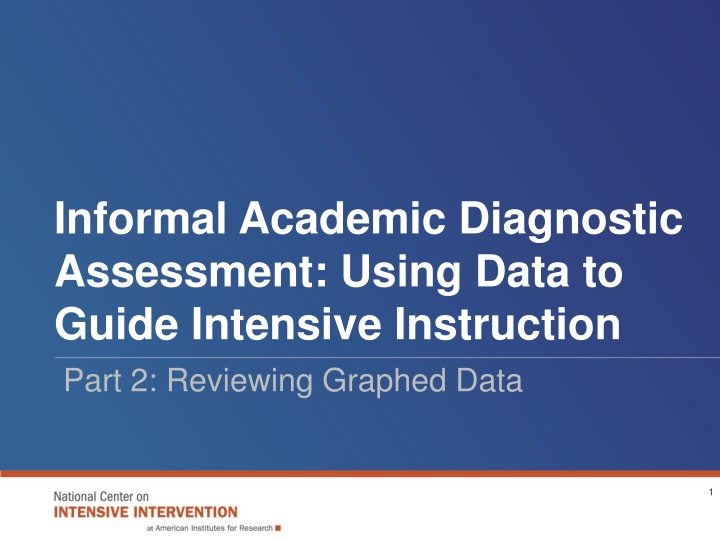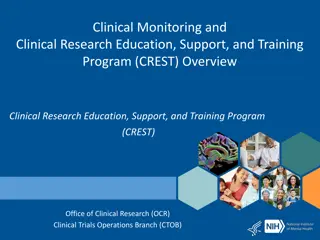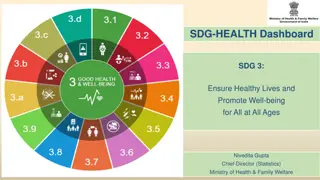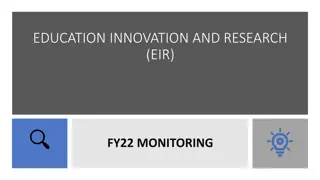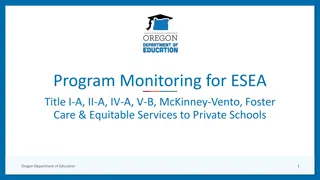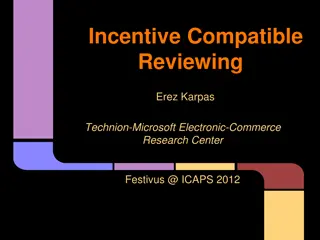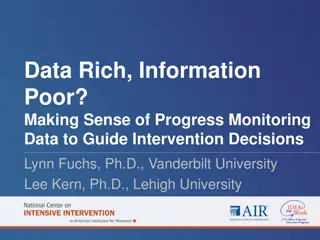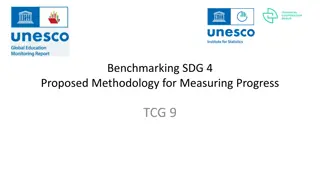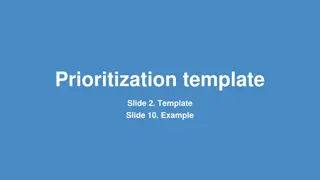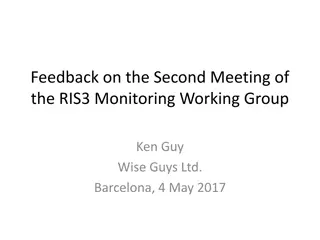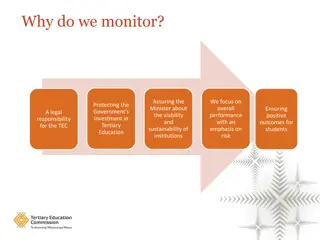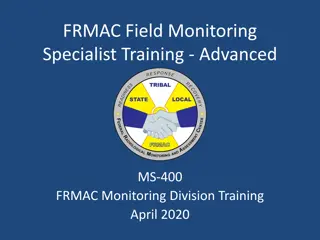Reviewing Graphed Data for Academic Progress Monitoring
Explore the process of reviewing graphed progress monitoring data to assess student response to interventions and determine necessary changes. Learn the basics of graphing, setting goals, and interpreting data trends to enhance individualized instruction and improve student achievement.
Download Presentation

Please find below an Image/Link to download the presentation.
The content on the website is provided AS IS for your information and personal use only. It may not be sold, licensed, or shared on other websites without obtaining consent from the author.If you encounter any issues during the download, it is possible that the publisher has removed the file from their server.
You are allowed to download the files provided on this website for personal or commercial use, subject to the condition that they are used lawfully. All files are the property of their respective owners.
The content on the website is provided AS IS for your information and personal use only. It may not be sold, licensed, or shared on other websites without obtaining consent from the author.
E N D
Presentation Transcript
Informal Academic Diagnostic Assessment: Using Data to Guide Intensive Instruction Part 2: Reviewing Graphed Data 1
Informal Academic Diagnostic Assessment: Using Data to Guide Intensive Instruction Administering Academic Progress Monitoring Data Reviewing Progress Monitoring Data Miscue and Skills Analysis Identifying Target Skills 2
Purpose and Objectives Purpose: To provide guidance on reviewing graphed progress monitoring data, helping teachers determine 1. If the student is responding sufficiently to the intervention 2. What type of intervention changes may be needed 3
Quick Review of Graphing Why graph progress monitoring data? Allows staff to see patterns and compare performance to goals More accurate data analysis Individualize instruction Increased student achievement 4
Quick Review of Graphing: The Basics Plot student s first few data points Baseline data or starting point 5
Quick Review of Graphing: The Basics First 3 scores represent baseline Draw vertical line after baseline 6
Quick Review of Graphing: The Basics Determine a goal for your student s performance at the end of the year. 7
Quick Review of Graphing: The Basics Goal Draw a line connecting baseline performance to goal This is the goal line Shows the rate of progress a student must achieve to reach goal by the end of the year 8
Quick Review of Graphing: The Basics Continue to collect and graph the student s progress monitoring scores. If four consecutive scores fall below the goal line, as shown here, you should change your instruction. If scores are at or above the goal line, continue instruction and data collection. 9
Quick Review of Graphing: The Basics When you have at least six scores after baseline, you can use the scores to draw a trend line that represents the student s rate of progress. 10
Quick Review of Graphing: The Basics If the trend line is flat or going down Change your instructional program. If the trend line is less steep than the goal line Adjust your instructional program to try to increase the student s rate of improvement. 11
Quick Review of Graphing: The Basics When you make an instructional change, add a vertical line to the graph showing when you made the change. Then continue collecting data to help you determine whether the instructional change has been effective. 12
Its time to make a change, but what should I do? Observing data patterns can help guide your decision-making. 13
Potential Issues Impacting Progress While reviewing student progress monitoring data, it is important to consider other issues that may be impacting progress: Progress monitoring Engagement/motivation Fidelity Instructional platform 14
Goal line steeper than trend line. What can a graph tell you? Very low scores. Trend line steeper than goal line. Highly variable scores. Flattened scores after teaching change. Flat line trend. Increasing scores after teaching change. 15
How do I know when a change is needed? When you make your first decision based on progress monitoring data, ask yourself two questions: 1) Is the student s performance improving? 2) If so, is the student s performance improving sufficiently to meet the end of the year goal? 16
Graphs: Very low scores The situation: Your student s scores are very low, close to the bottom of the graph. 17
Consider Are there issues with your progress monitoring measure or process? 18
Graphs: Highly variable scores The situation: Your student s scores are highly variable with a lot of bounce from day to day. 19
Consider Are you using a technically sound (valid, reliable) measure? 20
Consider Consistency: is the assessment occurring at the same time of day, days of the week, setting, etc.? 21
Consider Does the student s engagement or motivation level vary from day to day? 22
Graphs: Flat trend line The situation: The trend line of your student s scores is flat or going down, indicating that the student s performance isn t changing. 23
Consider Has the plan been implemented as intended? Have other factors prevented the student from receiving the instruction as planned? Scheduling conflicts? Attendance? Behavior/motivation? 24
Graphs: Goal line steeper than trend line The situation: The trend line of your student s scores is increasing, but not as steeply as the goal line. 25
Consider Did the teacher use an appropriate procedure/method to set the goal? 26
Consider Build on or modify the intervention or your approach to progress monitoring, rather than trying something completely different 27
Graphs: Trend line steeper than goal line The situation: The trend line of your student s scores is increasing more steeply than the goal line. 28
Consider Was the original goal ambitious enough? 29
Graphs: Scores flat after change The situation: After an instructional change, your student s scores do not improve. 30
Consider Why might the original intervention have worked better for the student? Use this insight to make an informed instructional change. 31
Graphs: Scores improving after change The situation: After an instructional change, the trend line is steeper than before the change was made. 32
Consider What you re doing is working. Continue the intervention and monitor the student s progress through the end of the year. 33
In Summary Begin with a valid, reliable, and appropriate progress monitoring measure. Graph your data to see patterns. Ask questions about data patterns to arrive at hypothesis about student responsiveness. Use your hypothesis to inform changes to intervention or assessment (if the data indicate that a change is needed). 34
